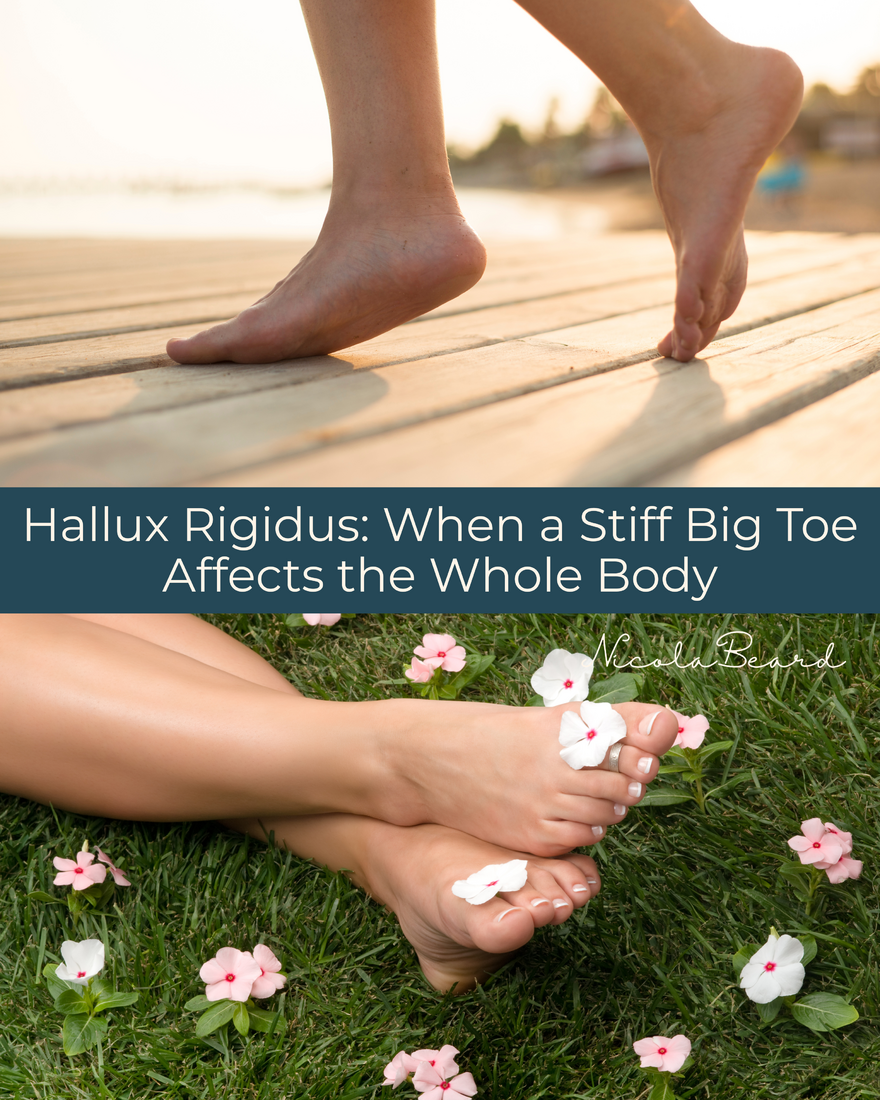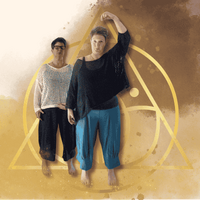
The big toe joint is one of the most important yet most overlooked joints in the body. It provides leverage for walking, maintains balance during standing, and contributes to the body’s overall stability. When this joint stiffens or becomes painful, as in hallux rigidus, the effects reach far beyond the foot. The change alters how we walk, how we distribute weight, and how other joints throughout the body respond.
Hallux rigidus literally means “stiff great toe.” It is a degenerative joint condition, but its consequences are mechanical as much as arthritic. The restricted motion in one small joint can set off a series of adjustments that travel up through the ankles, knees, hips, and spine. This chain reaction leads not only to discomfort, but also to long-term changes in posture, muscle tone, and balance.
Understanding the biomechanics behind this process is essential. It explains why foot health is fundamental to movement health, and why local stiffness in the toe can become a whole-body issue if ignored. Early recognition and movement-based prevention can help maintain mobility, reduce pain, and protect long-term function.
1. What Is Hallux Rigidus?
Hallux rigidus is a form of arthritis that affects the metatarsophalangeal joint at the base of the big toe. The joint cartilage gradually wears down, leading to stiffness, pain, and restricted movement. Common contributing factors include genetic predisposition, previous injury, altered foot mechanics that overload the joint, and footwear that restricts natural motion by holding the toes in a fixed position. In many people, the problem develops not from repetitive strain but from insufficient movement over time, as the joint becomes progressively less used and loses its natural mobility.
Common signs develop gradually and include:
Pain or stiffness when walking or pushing off
Limited ability to bend the big toe upwards
Swelling or enlargement around the joint due to bone spurs
Difficulty wearing shoes with rigid soles
If left untreated, the joint progressively loses mobility, leading to compensatory movement patterns throughout the body.
2. The Functional Role of the Big Toe
Each step depends on an efficient push-off from the big toe. During gait, around 40 per cent of body weight passes over this joint. It must bend upwards by at least 60 degrees to allow the body to move forward efficiently. When that movement is restricted, the body adapts by changing how it walks. These adaptations are automatic but mechanically costly.

3. How the Foot Compensates
When the big toe joint locks, other structures in the foot must absorb the lost motion. This alters how pressure travels across the sole and how the muscles activate.
Key effects include:
Lateral weight shift: The body rolls onto the outer edge of the foot to avoid bending the joint, leading to overload on the smaller toes and outer ankle.
Increased pressure on lesser toes: The second and third toes take excessive load, often resulting in hammer or claw toe deformities and painful calluses.
Reduced arch function: The natural rise and fall of the arch depends on big toe mobility. Restriction can flatten or rigidify the arch, altering the spring-like function of the foot.
Risk of plantar fasciitis: Reduced movement through the big toe and arch increases strain on the plantar fascia, causing heel or mid-foot pain.
Bunion formation and nerve irritation: Changes in load and friction may create bunions or compress nerves, producing tingling or numbness in the forefoot.
These changes make walking less efficient and increase overall fatigue, even in short periods of standing or movement.
4. How It Affects the Rest of the Body
The effects of hallux rigidus do not stop at the foot. The altered gait pattern sends a ripple up through the kinetic chain.
Knee strain: Twisting or locking the knee to avoid toe bending increases joint stress and ligament tension.
Hip tension and reduced rotation: Compensatory walking patterns cause tightness in the hip flexors and reduced pelvic mobility.
Pelvic and spinal strain: Uneven weight transfer leads to pelvic tilting and lumbar stiffness, often presenting as lower back discomfort and pelvic floor dysfunction.
Shoulder and neck tension: When gait becomes uneven, arm swing is disrupted, creating tension through the shoulders and upper spine.
Reduced balance: The big toe provides critical sensory feedback for stability. Stiffness reduces this feedback, increasing the risk of imbalance or falls.
Over time, these adaptations increase overall muscular workload. Movement becomes less efficient and more tiring, contributing to the feeling of general fatigue.

5. The Emotional and Lifestyle Impact
Loss of foot mobility affects daily life far beyond physical symptoms. Many people unconsciously begin avoiding walks, exercise classes, or stairs. Activity levels drop, confidence in movement declines, and overall wellbeing suffers. Frustration, worry, and reduced social engagement are common. This illustrates how closely physical freedom and mental wellbeing are linked.
6. Restoring Function and Preventing Progression
Early intervention is key. The goal is to restore as much joint movement and foot strength as possible while retraining how the body moves.
Effective approaches include:
Foot mobilisation and strengthening: Gentle joint mobilisations and targeted exercises restore mobility and stability.
Soft tissue release: Manual therapy reduces tension in surrounding muscles and fascia, improving circulation and comfort.
Appropriate footwear: Shoes with flexible soles and wider toe boxes reduce compression and encourage natural movement.
Whole-body retraining: Addressing hip, knee, and spinal alignment restores efficient gait patterns.
Gradual load reintroduction: Supporting natural push-off and weight transfer retrains both the joint and the nervous system to move confidently again.
The aim is to restore balance and control, not restrict movement with braces or rigid supports that may reduce long-term strength.
7. Prevention Through Movement
Consistent, low-impact movement helps maintain joint nutrition, flexibility, and neuromuscular control. Practices that emphasise weight transfer, awareness, and balance are particularly beneficial.
Tai Chi Qigong Shibashi is one such approach. The slow, repetitive movements train controlled weight shifting, stimulate joint circulation, and maintain mobility in the toes and feet. Practising regularly helps preserve natural gait mechanics and balance, promotes improved circulation to the feet, and supports the healing process, reducing the risk of further stiffness, pain or instability.
Conclusion
Hallux rigidus is often dismissed as a minor foot condition, but the mechanics of walking prove otherwise. The big toe is a structural anchor for efficient movement, and once it becomes stiff, the effects spread far beyond the joint itself. What begins as local pain can evolve into postural imbalance, reduced mobility, and loss of confidence in movement. Recognising the early signs allows for proactive care before those patterns become fixed.
The good news is that change is possible at any stage. With attention to joint mobility, posture, and functional movement, much of the lost range can be recovered, and pain reduced. Consistent practice, whether through specific exercises or mindful movement such as Tai Chi Qigong Shibashi, helps retrain coordination and restore healthy gait mechanics. This not only supports the feet but benefits the entire body’s alignment and balance.
Healthy movement begins from the ground up. Protecting and maintaining the mobility of the big toe is one of the most effective ways to safeguard posture, prevent pain, and maintain independence through later life.

